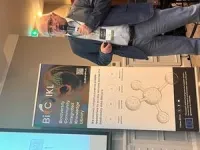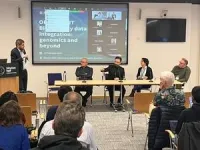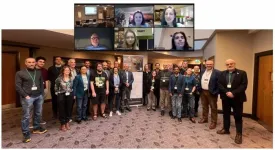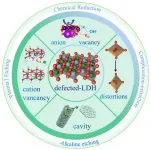(Press-News.org) If we could stand in a landscape that our Mesolithic ancestors called home, what would we see around us? Scientists have devised a method of analyzing preserved hazelnut shells to tell us whether the microhabitats around archaeological sites were heavily forested or open and pasture-like. This could help us understand not only what a local environment looked like thousands of years ago, but how humans have impacted their habitats over time.
“By analyzing the carbon in hazelnuts recovered from archaeological sites in southern Sweden, from Mesolithic hunter-gatherer campsites through to one of the largest and richest Iron Age settlements in northern Europe, we show that hazelnuts were harvested from progressively more open environments,” said Dr Amy Styring of the University of Oxford, lead author of the article in Frontiers in Environmental Archaeology.
Neolithic Nutella
Humans in northern Europe have been using hazel trees as a source of materials and food for thousands of years. For the people who collected hundreds of hazelnuts found at Mesolithic and Neolithic sites, they were a valuable resource.
“The nuts are an excellent source of energy and protein, and they can be stored for long periods, consumed whole or ground,” said Dr Karl Ljung of Lund University, Sweden, senior author of the article. “The shells could also have been used as a fuel.”
Like all plants, hazel trees contain carbon, which exists in different forms known as isotopes. The proportions of the different carbon isotopes are altered by the ratio of carbon dioxide concentrations between leaf cells and in the surrounding environment. In plants like hazel, this ratio is strongly affected by sunlight and water availability; where water is not scarce, as in Sweden, sunlight influences the ratio much more. Where there are fewer other trees to compete for the sunlight and rates of photosynthesis are higher, the hazels will have higher carbon isotope values.
“This means that a hazelnut shell recovered on an archaeological site provides a record of how open the environment was in which it was collected,” explained Ljung. “This in turn tells us more about the habitats in which people were foraging.”
Gleaning information
To test whether this effect can be seen in archaeological samples, the scientists gathered hazelnuts from trees growing in varying light levels at three locations in southern Sweden, and analyzed the variation in their carbon isotope values and the relationship between these values and the light levels the trees were exposed to. They then investigated the carbon isotope values of hazelnut shells from archaeological sites also found in southern Sweden. They selected shell fragments from four Mesolithic sites and eleven sites ranging from the Neolithic to the Iron Age, some of which had been occupied in more than one period.
Using the reference values and the archaeological results, the archaeologists ran a model to assign their hazelnut samples to one of three categories: closed, open, and semi-open. Because the carbon isotopes of an individual hazelnut will naturally vary a little from those of other hazelnuts growing in similar environments, the scientists used multiple samples from each site and assessed the proportion of hazelnuts which had grown in closed or open environments.
Growing changes
The scientists found that nuts from the Mesolithic had been collected from more closed environments, while nuts from more recent periods had been collected in more open environments. By the Iron Age, most of the people who collected the hazelnuts sampled for this study had gathered the nuts from open areas, not woodlands. Their microhabitats had completely changed. This is consistent with environmental reconstructions from pollen analyses, but isotope analysis can be used to visualize a local environment where pollen records are scarce.
“Our study has opened up new potential for directly tying environmental changes to people’s foraging activities and reconstructing the microhabitats that they exploited,” said Styring. “We would like to directly radiocarbon date and measure the carbon isotopes of hazelnut shells from a wider range of archaeological sites and settings. This will provide much more detailed insight into woodlands and landscapes in the past, which will help archaeologists to better understand the impact of people on their environment, and perhaps help us to think differently about woodland use and change today.”
END
Seeing the wood for the trees: how archaeologists use hazelnuts to reconstruct ancient woodlands
Archaeologists analyze the carbon isotope values of hazelnuts from ancient sites to see what the local woods were like
2024-02-29
ELSE PRESS RELEASES FROM THIS DATE:
EU-funded Biodiversity Community Integrated Knowledge Library (BiCIKL) project sums up outcomes and future prospects at a Final GA in Cambridge
2024-02-29
The city of Cambridge and the Wellcome Campus hosted the Final General Assembly of the EU-funded project BiCIKL (acronym for Biodiversity Community Integrated Knowledge Library): a 36-month endeavour that saw 14 member institutions and 15 research infrastructures representing diverse actors from the biodiversity data realm come together to improve bi-directional links between different platforms, standards, formats and scientific fields. Consortium members who could not attend the meeting in Cambridge joined the meeting remotely.
The ...
Detailed study demonstrates how pulse oximeters significantly overestimate oxygen readings in people with darker skin tones
2024-02-29
Pulse oximeters – one of the most common medical devices used in global healthcare – can provide significantly overestimated oxygen saturation readings in people with darker skin tones, according to the most comprehensive study ever to explore the issue.
Published in the British Journal of Anaesthesia, the new study is based on a systematic review of previous research into the use of the devices, and examined 44 studies dating from the mid-1970s to the present day.
In the course of that, researchers assessed more than 733,000 oxygen saturation readings taken from over 222,000 people – including almost ...
Virtual walking by synthesizing avatars into a 360-degree video
2024-02-29
Overview:
Researchers at the Toyohashi University of Technology and the University of Tokyo developed a system that provides a virtual walking experience to a seated person by real-time synthesis of a walking avatar and its shadow on a 360-degree video with vibrations to the feet. The shadow of the avatar induces an illusory presence of their body. In the future, it is expected to provide an immersive experience for any recorded medium with a virtual embodiment.
Details:
Walking is a fundamental activity for humans ...
How to make difficult-to-cut materials and components “easy-to-cut”?
2024-02-29
Difficult-to-cut materials such as titanium alloys, high-temperature alloys, metal/ceramic/polymer-matrix composites, hard and brittle materials, as well as geometrically complex components such as thin-walled structures, micro channels and complex surfaces, are widely used in aerospace community. Nevertheless, many problems including severe and rapid tool wear, low machining efficiency, and poor surface integrity exist in mechanical machining. How to efficiently and precisely process these materials and components, i.e., make difficult-to-cut ...
Defects engineering of layered double hydroxide-based electrocatalyst for water splitting
2024-02-29
In the context of the gradual depletion of fossil fuels and the energy crisis, hydrogen energy has attracted widespread attention due to its ultra-high energy density and eco-friendly properties. However, most of the hydrogen production still relies on fossil fuels, with less than 1 million tonnes produced as low-emission hydrogen in 2021, which means it has limited benefits in mitigating the energy crisis and environmental degradation. Alternatively, hydrogen production via water electrolysis has the advantages ...
International symposium to converge food-energy-water research for net zero development scheduled for March
2024-02-29
Researchers with the University of Tennessee, Knoxville, and Oak Ridge National Laboratory are hosting an international symposium focused on efforts to make urban and rural communities healthy and resilient to changes in climate, demographics, natural resources and ecosystems.
The “Food-Energy-Water Bioeconomies for Net-Zero Transition” international conference will be March 18-20 in Knoxville. The interdisciplinary conference is sponsored through a U.S. National Science Foundation grant awarded to a team led by Jie ...
Walking, reminiscing benefit brain health in older Black adults
2024-02-29
An innovative Oregon Health & Science University research program that enlists older Black adults to walk through and reminisce about historically Black neighborhoods in Portland — which now look very different after rapid change through gentrification — may help improve cognitive function, a new study finds.
The OHSU project has gained wide interest since its 2016 launch, with similar versions beginning to take root in Seattle and Oakland, California.
Now, newly published research suggests it may improve brain health in a population that’s disproportionately affected by Alzheimer’s disease. The study, published online ...
Uncovering the connections between autism, sensory hypersensitivity
2024-02-29
Supported by a $2 million R01 grant from the National Institutes of Health, the Auerbach Lab at the Beckman Institute for Advanced Science and Technology will examine how different genes associated with autism spectrum disorders may similarly impact our brain’s neurons, resulting in heightened sensitivity to sounds.
Autism spectrum disorders are genetically complex, and hundreds of genes are implicated in their development. As a result, some may conclude that autism is a collection of disconnected disorders with comparable symptoms. However, much like how roads converge as they approach a destination, at some level of brain function ...
Medical University of South Carolina neuroscientist honored for trailblazing pain management research
2024-02-29
Medical University of South Carolina neuroscientist Bashar Badran, Ph.D., was one of only 10 investigators nationwide recognized for their research at the fifth annual scientific meeting of the National Institutes of Health – Helping to End Addiction Long-Term (NIH HEAL) Initiative in Bethesda, Maryland. Badran received an honorable mention for the NIH HEAL Initiative Trailblazer Award.
The NIH HEAL Initiative provides funding to encourage scientific research into opioid use and pain management to fast-track progress in the face of the country’s current opioid epidemic. Its Trailblazer ...
Researchers decipher mysterious growth habit of weeping peach trees
2024-02-29
A basic premise of how plants grow is that shoots grow up and roots grow down. A new study, published in Plant Physiology, a leading international society journal published by the American Society of Plant Biologists, reveals the answer to a fascinating question: why do weeping tree varieties defy this natural growth pattern?
Researchers identified a protein called WEEP that is missing from the Weeping Peach Tree. Their results show how a DNA deletion in just one gene completely changes the localization of the hormone auxin, which ...
LAST 30 PRESS RELEASES:
JULAC and Taylor & Francis sign open access agreement to boost the impact of Hong Kong research
Protecting older male athletes’ heart health
KAIST proposes AI-driven strategy to solve long-standing mystery of gene function
Eye for trouble: Automated counting for chromosome issues under the microscope
The vast majority of US rivers lack any protections from human activities, new research finds
Ultrasound-responsive in situ antigen "nanocatchers" open a new paradigm for personalized tumor immunotherapy
Environmental “superbugs” in our rivers and soils: new one health review warns of growing antimicrobial resistance crisis
Triple threat in greenhouse farming: how heavy metals, microplastics, and antibiotic resistance genes unite to challenge sustainable food production
Earthworms turn manure into a powerful tool against antibiotic resistance
AI turns water into an early warning network for hidden biological pollutants
Hidden hotspots on “green” plastics: biodegradable and conventional plastics shape very different antibiotic resistance risks in river microbiomes
Engineered biochar enzyme system clears toxic phenolic acids and restores pepper seed germination in continuous cropping soils
Retail therapy fail? Online shopping linked to stress, says study
How well-meaning allies can increase stress for marginalized people
Commercially viable biomanufacturing: designer yeast turns sugar into lucrative chemical 3-HP
Control valve discovered in gut’s plumbing system
George Mason University leads phase 2 clinical trial for pill to help maintain weight loss after GLP-1s
Hop to it: research from Shedd Aquarium tracks conch movement to set new conservation guidance
Weight loss drugs and bariatric surgery improve the body’s fat ‘balance:’ study
The Age of Fishes began with mass death
TB harnesses part of immune defense system to cause infection
Important new source of oxidation in the atmosphere found
A tug-of-war explains a decades-old question about how bacteria swim
Strengthened immune defense against cancer
Engineering the development of the pancreas
The Journal of Nuclear Medicine ahead-of-print tip sheet: Jan. 9, 2026
Mount Sinai researchers help create largest immune cell atlas of bone marrow in multiple myeloma patients
Why it is so hard to get started on an unpleasant task: Scientists identify a “motivation brake”
Body composition changes after bariatric surgery or treatment with GLP-1 receptor agonists
Targeted regulation of abortion providers laws and pregnancies conceived through fertility treatment
[Press-News.org] Seeing the wood for the trees: how archaeologists use hazelnuts to reconstruct ancient woodlandsArchaeologists analyze the carbon isotope values of hazelnuts from ancient sites to see what the local woods were like







